So I'm creating an screen with 5 BottomNavigationBarItem(s) that would ideally persist, while the AppBar changes according to the design. Here's my code:
class ExploreState extends State<ExploreScreen> {
int _selectedIndexForBottomNavigationBar = 0;
void _onItemTappedForBottomNavigationBar(int index) {
setState(() {
_selectedIndexForBottomNavigationBar = index;
});
}
@override
Widget build(BuildContext context) {
return new DefaultTabController(
length: 3,
child: new Scaffold(
appBar: AppBar(
bottom: ColoredTabBar(
color: Colors.white,
tabBar: TabBar(
labelColor: Colors.grey[900],
indicator: UnderlineTabIndicator(
borderSide: BorderSide(color: kPrimaryColor, width: 2.0),
),
tabs: <Widget>[
Tab(text: "Job Posts"),
Tab(
text: "Agencies",
),
Tab(
text: "All Applicants",
),
],
),
),
elevation: 0.7,
centerTitle: true,
title: Text(
"Looking For",
style: TextStyle(fontSize: 18),
),
actions: <Widget>[
Icon(Icons.search),
Padding(
padding: const EdgeInsets.symmetric(horizontal: 5.0),
),
],
),
body: TabBarView(
children: <Widget>[
Jobs(),
Agencies(),
Applicants(),
],
),
bottomNavigationBar: BottomNavigationBar(
type: BottomNavigationBarType.fixed,
items: <BottomNavigationBarItem>[
_bottomNavigationBarItem(
AssetImage("assets/images/search-job.png"), 'Explore'),
_bottomNavigationBarItem(
AssetImage("assets/images/message.png"), 'Messaging'),
_bottomNavigationBarItem(
AssetImage("assets/images/forums.png"), 'Forums'),
_bottomNavigationBarItem(
AssetImage("assets/images/notifications.png"), 'Notifications'),
_bottomNavigationBarItem(
AssetImage("assets/images/profile.png"), 'Edit Profile'),
],
currentIndex: _selectedIndexForBottomNavigationBar,
selectedItemColor: kPrimaryColor,
onTap: _onItemTappedForBottomNavigationBar,
selectedFontSize: 0,
),
),
);
}
BottomNavigationBarItem _bottomNavigationBarItem(
AssetImage icon, String label) {
return BottomNavigationBarItem(
activeIcon: _navItemIcon(
icon, label, [kPrimaryColor, kPrimaryWelcomeColor], Colors.white),
icon: _navItemIcon(
icon, label, [Colors.white, Colors.white], Color(0xFF4E5969)),
label: "",
);
}
Row _navItemIcon(AssetImage icon, String label, List<Color> backgrondColor,
Color? foregroundColor) {
return Row(
children: [
Expanded(
child: Container(
decoration: BoxDecoration(
gradient: LinearGradient(
begin: Alignment.bottomLeft,
end: Alignment.topRight,
colors: backgrondColor,
transform: GradientRotation(1.5),
),
),
child: Padding(
padding: const EdgeInsets.all(15.0),
child: Column(
children: [
ImageIcon(
icon,
size: 25,
color: foregroundColor,
),
Text(
label,
style: TextStyle(color: foregroundColor, fontSize: 8),
)
],
),
),
),
),
],
);
}
}
class ColoredTabBar extends Container implements PreferredSizeWidget {
ColoredTabBar({this.color = Colors.white, this.tabBar});
final Color color;
final TabBar? tabBar;
@override
Size get preferredSize => tabBar!.preferredSize;
@override
Widget build(BuildContext context) => Container(
color: color,
child: tabBar,
);
}
Upon Login, they land on the 'Explore' screen but was wondering if this structure is ideal. What I was thinking was a 'common' scaffold for a blank body, 5 BottomNavigationBarItems and a changing AppBar Menu items (for instance, "Messaging" has "Conversations" and "Appointments" AppBar items)
How do we go about properly coding this.
Here is a Sample for the "Messaging" BottomNavigationBarItem.

